I typed up the below for a couple of reasons – more on that later – but I thought the world might find it useful.
Good morning, and thanks for having me.
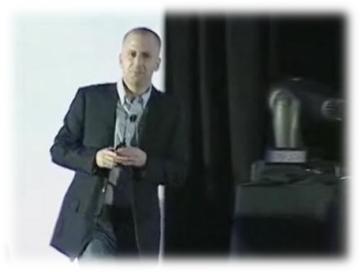
It’s really exciting to be here today, to talk to probably the most “with-it” energized, engaged audience that we’ve come across as we’ve been building out a hyperlocal news and media business for the past couple of years.
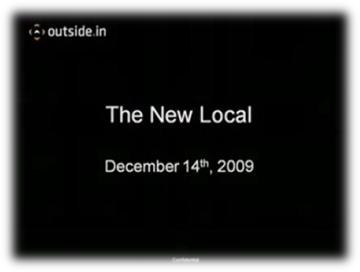
What’s we’re going to talk about today are the trends and the dynamics that are happening in local media that are impacting everything from how your customers find you, where the ad dollars are being spent, where customer attention is being spend and how that might impact you.
So I’m going to try to cover three things.
The first are the trends that we see that are impacting the local media landscape.
Two, one of the models that we see that emerging from all the disruption and excitement that’s happening.
And then the third is what this might mean for you.
There’s another panel that I’m sitting on this afternoon where we’ll get a little more specific about what we do, and looking forward to talking about all of that.
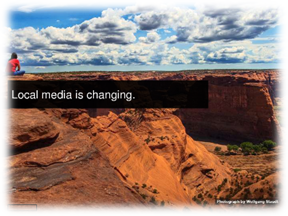
So, it’s an unbelievably exciting time to be working in media, to be a startup focused on high-growth opportunities, and in a market where things are changing every day… you can’t pick up the paper – if you still pick up the paper – without reading about a new company or an old company that’s changing and what’s happening there.
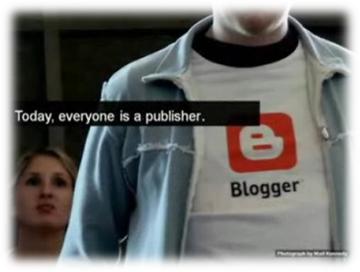
So I’m going to talk about a couple of important trends.
The first is that the cost to create content in local media in any media, and distribute that content, has dropped it to almost nothing… the internet has taken the printing press, and made it… well, I guess that the printing press is now the metaphor that people sue for old businesses.
And for local, particularly local content, used to be dominated by monopolies. There used to be the newspaper, the television station, and the local content used to be just that article that was in the newspaper. That was pretty much just about it.
Today, completely upside down… there are still those articles in the newspapers, though fewer of them, there are local bloggers, y’know we see up to 10,000 local bloggers covering very specific neighborhoods, doing it for passion, doing it for expertise and effectively talking about what’s happening in their neighborhoods at a level that nobody else has ever covered before.
We see people will cellphones taking pictures of planes landing in the Hudson river, that picture turns up on the front page of CNN Today… that never would have happened years ago.
We see people Tweeting about waiting in line at concerts, we see checking in on FourSquare… the amount of content, municipal data, crime reports… potholes that need to be fixed… the amount of data, the amount of content that’s being created at the local level is overwhelming.
It’s about abundance. It used to be scarcity.
Today, there’s just frankly too much content that exists in your local markets, and the challenge is how do you organize that and make it valuable for people.
So one, everybody’s the published today. In New York, there are 8 million publishers, because we’re all doing something to express some information about what’s happening around us.
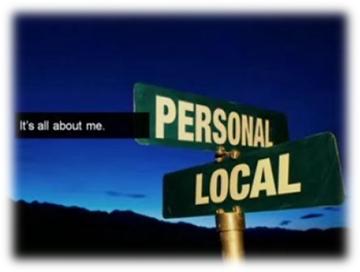
Second trend is that consumers’ expectations, customers’ expectations for targeting and specificity are getting more and more highly-tuned. We expect to get an email alert when the wide receiver on our fantasy football team blows out his knee. We only want to hear about art, the stocks that we buy, the houses that we’re interested in buying… the teams and information and the companies that are interesting to me… I was talking to somebody the other day about the experience about going to… remember when everyone used to use MyYahoo as their homepage, and the first time you went there it was really untargeted, because you hadn’t customized it yet? It used to be really exciting and interesting to customize that. Today, even that’s not good enough. The expectations are even more specific about what you should receive and how you should receive it.
Today, there’s this whole enabling thing that we’ll talk about that enables the specificity to happen on a local level as well.
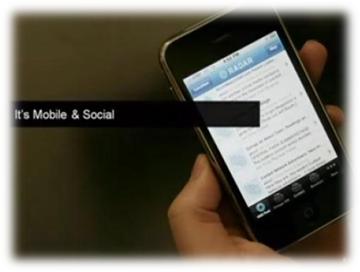
The next trend that’s impacting local media is mobile.
We’re all carrying little computer in our pocket, those computers are uh increasingly location-away… they have GPS, your browsers that you’re using on your desktop computers are now location away, your cars are now location aware, and we joke that eventually your toaster will be location aware.
Knowing where you are is incredibly easy to do, both for you as a consumer but also for the business and services that are trying to reach you as a consumer, and the next question is if you know where you are, what’s happening around you?
And that’s some of the thing that’ we’re going after to try to fill in… and it’s increasingly social, it’s so easy to share information, and there’s been some great examples… FourSquare is fantastic, Twitter is easy… Facebook and sharing pictures and Pegshot, great ways to hare information about what’s going on around you, and that’s leading to an unbelievable amount of information… not all of it has value, some of it has less value than others, but there’s an incredible amount of information and it’s flowing through your mobile devices and its increasingly so.
I saw a stat this morning that by 2013 the mobile web will bigger than the desktop web… I didn’t read the whole story so maybe there’s a caveat to that.
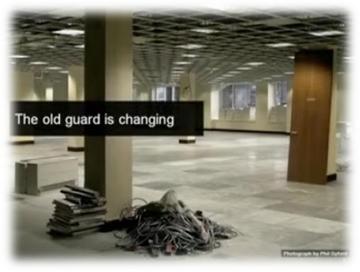
The following trend is undeniable and it makes for good reading during the week, but the old guard is changing. There’s no denying that the incumbents in any given market used to be the newspapers, they’re not anymore in the way that they … they’re not today and they won’t be tomorrow in the way in which they’re currently constituted.
There’s a tremendous amount… we work with hundreds of them, because we’re trying to help them and we’re providing services to help them, get to the next level and the next models, and there’s two different categories that we see. We see those that are, who are really trying very hard to reinvent themselves… and you can see great examples of that with folks like the New York Times and what they’re doing with Local, and the New York Post, and the 200 neighborhood pages, sections on their web site (which we do for them – full disclosure). And you see new interesting models being invented from more traditional companies, so AOL is doing Patch… there’s startups like Neighborlogs and Prism and interesting businesses that are trying to create a new model for hyperlocal or local media publishing.
So the barriers that existed don’t exist anymore.
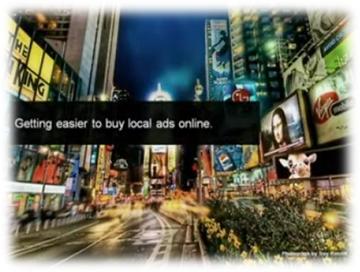
The… you had to buy the Sunday paper or you had to buy the ad at this place because that’s the only place you could get your customers, and that’s just not happening anymore. We see that now as local advertisers are really starting to stream online, and people are starting to spend dollars targeted at local in a way that hasn’t happened before.
There were $115 billion dollars spent in local advertising. $15 billion of it is online, only $15 billion, but that number is picking up steam and it’s happening quickly. And it’s happening because the circulation and reach of the traditional print publications, and there effectiveness… is dropping. It’s just not working as well as it used to.
If you think about customers expectations about more enhanced targeting and relevance – that’s the same for ads. Consumers actually embrace targeted ads; we click on ads that are relevant to the queries that we make, and if we’re looking for something and we see an ad that’s relevant, that’s great content.
What we’re seeing is local advertisers streaming towards transparency. They know what they want, they know the customers that they want, and they know where to find them… and streaming towards results based pricing.
I only want to pay for the things that work for me.
And there are great companies that are really tackling this problem. There are folks like Yodle, or for the individual buyer there’s folks like RealDirect – trying to do interesting things to bring success to local advertisers.
We see that happening and we see real progress being made there.
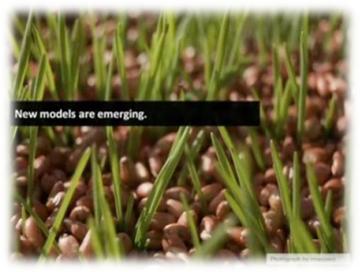
And that speaks to the new models that are emerging and it’s again as an entrepreneur and as a startup company, the ability to work in a market that is being re-written every single day is thrilling and I really believe, ’cause we’ve spent a lot of time with big publishers, we’ve spent a lot of time with local bloggers, we’ve spent a lot of time with local advertisers and real estate folks (as a great example of that) what’s happening on the macro-level with the big guys is exactly what’s happening on the micro-level with the little guys, and individual and local markets and neighborhoods.
The rules are being re-written, and the barriers to build your business and to develop an effective strategy [are] just not what they used to be, and that’s just very exciting for us and for our company and for the folks with whom we work.
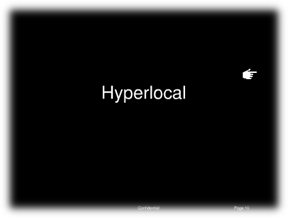
So… that leads to hyper-local.
We love hyperlocal, but people don’t always know what hyperlocal means.
So, hyperlocal for us is the obvious result of the confluence of the trends that we talked about. More content about more specific targeted places, technology that enables you to target that content – more local advertisers who have who are spending money on only
what works which means that the buys in the dollars you spend tend to be more focused and more targeted instead of trying to cast a wide net hoping you’ll catch people… and mobile that follows you around everywhere.
So hyperlocal is, for us, as the definition, a deep geographic media reach that is typically at a block, a neighborhood, or a street-level… ’cause you can actually now build a business around a one-block radius of a central point, and that could never [have] happen[ed] before.
And the thing that gets us, one of the things that gets us really excited is that what’s close to us is really important. Consumers value things that are close to [them], and advertisers get greater conversion, local advertisers, when proximity matters. When proximity is included.
But there’s also an emotional connection that exists in your neighborhood, that exists with your community. So, we often talk about hyper-local not being just what’s close to you, but what’s close to your heart and what’s close to your wallet, because that’s where dollars are being spent, and that’s where we think the opportunity continues to evolve and expand.
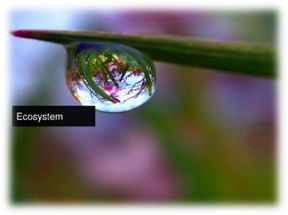
So… in order for hyper-local to exist and really grow, we believe that it’s reliant on an ecosystem, and this is one of our big points of view in the market.
In order for communities to grow, and systems to evolve, everybody needs to play a part.
And it used to be, again, a monopoly in a given market and now there’s complete transparency and atomization of the responsibilities… everybody owns something. An ecosystem is a model where everybody who takes something from the market puts something back in. Either overtly, covertly, intentionally, unintentionally… but you can’t just take value from the market, you have to provide value as well.
That’s what’s going to enable hyperlocal communities, hyperlocal media businesses, and success for local advertisers, in the market.
So, what does that mean in local and hyperlocal media?
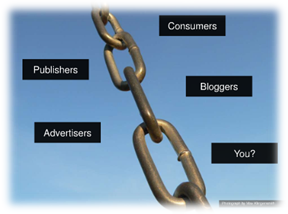
So there’s a couple of key players.
First is the publishers. The incumbents aren’t going away overnight, or entirely… they’re going to reinvent themselves and they’re going to be interesting. And those guys have actually a lot of traffic and a lot of audience in their local market that you can still be valuable to the ecosystem… and they also have great long-standing relationships with local advertisers that they can leverage, they just have… still have big printing presses that they’re trying to pay for.
There are advertisers in the room and in local markets who want to reach customers and who put dollars into the ecosystem, and can sponsor and create and foster the creativity and things that need to happen in local markets.
Consumers used to just take… let me read, and I’ll listen to a little bit of the advertising as well, but now with the advent of blogging and Twittering and Yelp and posting reviews and adding stars and taking pictures and checking in on FourSquare – we’re contributing, we’re all contributing to the market to the ecosystem and providing value in there.
And local bloggers are really filling a need, and a niche that never existed before… [well] the need always existed, but now they can cover what’s happening at the on the street corners, and in the neighborhoods that the traditional media can no longer afford to do, so they’re driving a lot of value.
So the last piece I want to talk about is perhaps what this means to folks in this room and to the real estate community.
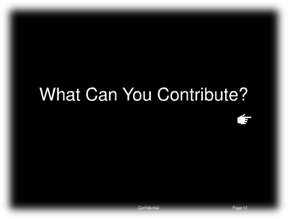
And… I’m not a real estate… I’m not an expert on real estate. I like to think that I’m well-versed in local and local media, and online. What I would ask of everybody in this room is similar to what I’d ask of people in other groups that we’d talk to, when they ask what role can they play in the local media and hyperlocal media ecosystem.
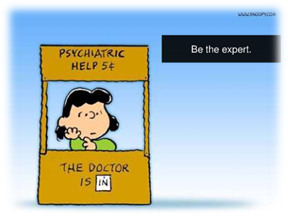
I would ask yourselves “What do I know better than anybody else in my market?” “What am I good at, what do I know, what value am I uniquely positioned to add to the market?”
And I know the best real estate professionals who I come in touch with that I come in touch with know more what’s happening in any neighborhood than any reporter, any blogger, any resident that exists there.
So I would ask: Take your expertise, take your knowledge of what’s important and what’s interesting, and start sharing that knowledge in a way that’s easier… there’s some great examples before. [Now] we’re not a company that will get you online, but we can help make your online presence really sing and become a definitive resource for that local neighborhood.
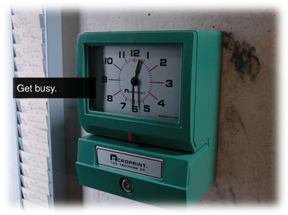
So, I would say that there are two things that you can do. The first is to start sharing that information online. If you have a blog, use it. If you don’t, create one. You should be Twittering, you should be sharing that information in a way that you can start to compete for audience online, and brand and attention. And if you have a website that’s for your neighborhood or for the regions that you’re working in, you can use our tools, and we’ll talk more about those later this afternoon, to help make it more robust, to help make it more of a destination, and easy to do.
And the second thing is start spending your marketing dollars on neighborhood-focused media players. There are more and more of us (and we’re not the only ones) but put dollars into the ecosystem so that you can have more choices. We all benefit when there are more choices in the market. And right now there’s a unique point in time when there’s a lot of startup companies and a lot of innovation that’s happening that could use some of those dollars in our direction, and it’s going to come back and help you because you’ll be building audience and finding new places to get customers and find your success.
And why do you do it?
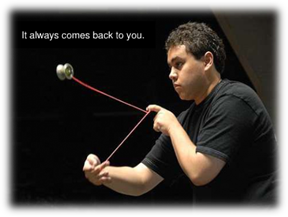
In the ecosystem, it all comes back to you. It’s more than just karma. I said there are 10,000 local bloggers, roughly, there’s anywhere between 50-80,000 neighborhoods as defined by folks like us as Neighbwise(?) that need information and need covering – and from a real tactical basis, people are searching on Google for information about neighborhoods. And you guys can compete.
I think local real estate professionals can compete for organic traffic in the organic unpaid search results by having a robust and easy web presence that you can enhance with our tools and with your with a little bit of effort. It’s safe to assume most people are competing for cost per click in Google AdSense audience, but there’s a way you can actually be competing in getting attention in driving traffic, driving leads, building your brands, in local markets through an organic editorial product that we can help you do. And if you spent dollars online like I said, targeting towards neighborhood focused brands, you can it’s going to come back tenfold, we believe, in fostering growth amongst those sorts of companies.
So, only one slide about who we are and what we do.
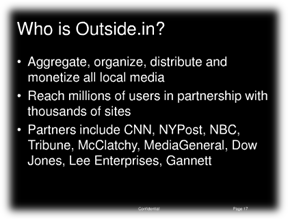
We aggregate, organize and distribute local media. We work with over 50,000 sources of local information, algorithmically organize it into 50,000 different neighborhoods, then we distribute it out to our own site, but in partnership with hundreds of media companies, like the New York Post, like the New York Times, like McClatchy, MediaGeneral, Down Jones, Lee Enterprises, and Gannett.
We’re reaching millions and millions of consumers every month, we partner with thousands of local bloggers, and we are focused really on helping sit in the middle of that ecosystem and develop value and create value for all the participants in there. At 4:30 I’ll be talking more about what we do and how we do it and what you can all do.
It’s an unbelievably exciting time to be working in local, to be in a conference again with the most engaging and exciting and excited people about what we’re doing.
So, thanks so much.
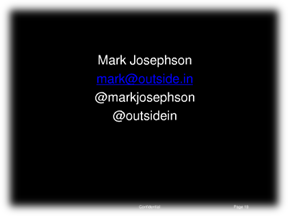
Post Revisions:
- February 3, 2010 @ 20:46:51 [Current Revision] by Michael Griffiths
- February 3, 2010 @ 20:39:41 by Michael Griffiths